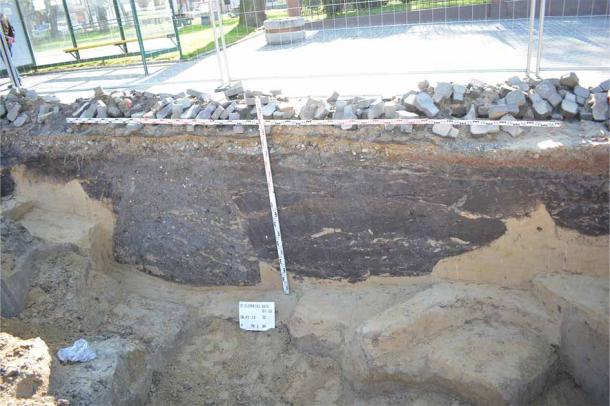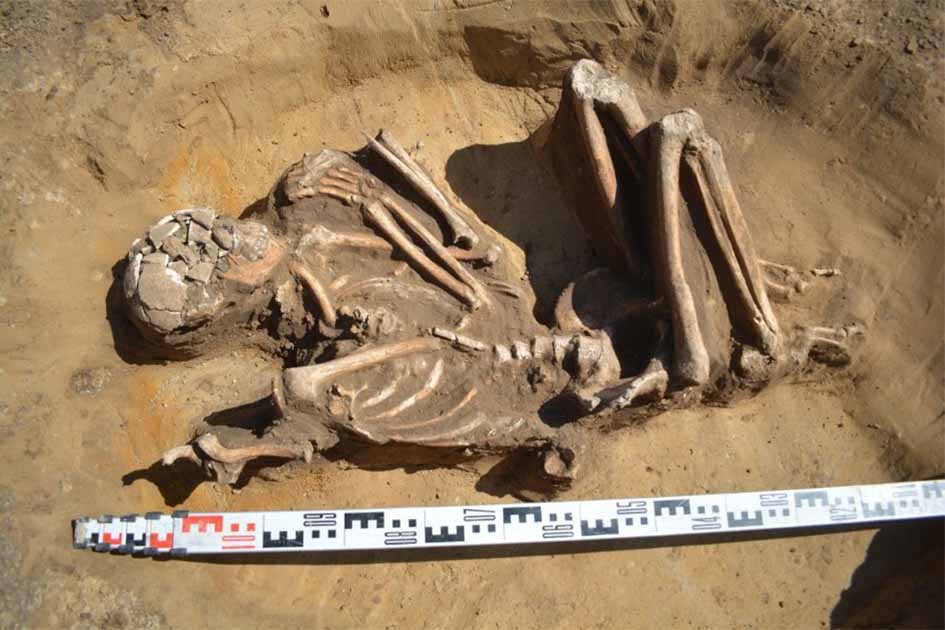7,000-Year-Old Skeleton in Foetal Position Discovered in Poland
Archaeologists in Poland have discovered a remarkably well preserved 7,000-year-old skeleton lying in the foetal position. The loosely packed soil with a non-acidic chemical composition acted as a natural preservative, protecting the skeleton. The burial was accompanied by fragments of pottery from the distinctive linear pottery culture.
A Well-Preserved Skeleton, Damaged Grave Goods
Paweł Micyk, an archaeologist with Galty Earth & Engineering Services, who led the excavation, shared these intriguing details in an email exchange with Live Science. “We expected to find the remains of the city walls from the mediaeval period, perhaps remnants of the city's beginnings. No one predicted that we would hit prehistoric objects… At the moment, we are unable to determine who the buried person was,” he added.
The discovery was made in the vicinity of Kraków, during the renovation of a town square in Słomniki. Alongside the burial, fragments of flint were also discovered, though unfortunately, some of the grave goods were damaged. Micyk revealed that the upper layer of the grave had been leveled at some point in the past, which was the likely cause of this damage. Upcoming analysis by an anthropologist and radio-carbon dating will likely shed further light on this.
The social dynamics of the Central European Lowlands in the ancient time period is one that has several missing pieces in the puzzle. The earliest Neolithic farmers who crossed the Carpathians from the south and entered Poland in the 6th millennium, faced the challenges of an unfavourable topography in the form of dense forests, along with a challenging climate, which presented formidable conditions for these pioneering settlers.
Little is known about their culture apart from their burial practices – the dead were buried within settlements and separate cemeteries, though the latter are very rare. The skeleton could perhaps prove to be one of the many vital missing pieces of the aforementioned puzzle.
The farmers also encountered pre-existing hunter-gatherer communities that had already established a presence in the area. The coexistence of these two distinct groups endured for approximately two millennia, yet the precise nature of their interactions remains somewhat elusive, as of now, reports The Science Times.
- Bizarre Burial: Girl With A Bird Skull In Her Mouth
- Unearthing The Baby Burning Witches Of Bochnia, Poland

The discovery came during work to revitalize the market square and replace paving stones in Słomniki. Credit: Paweł Micyk
The Linear Pottery Culture and the Early Neolithic Period in Poland
The migration of the earliest Neolithic farmers across the Carpathian Mountains into Poland during the 6th millennium BC marked a significant period of cultural and societal transformation in the region. This migration is associated with the spread of the Linear Pottery Culture (also known as LBK culture), named after its characteristic linear decorations on pottery.
The Neolithic period, meaning the "New Stone Age," represented a shift from a primarily hunter-gatherer lifestyle to one centered around agriculture and settled communities. The Neolithic farmers who crossed the Carpathians brought with them a suite of new practices and technologies, including domesticated plants and animals, pottery production, and a more sedentary way of life.
The migration of these early farmers from the south into Poland likely occurred as part of a larger wave of agricultural expansion across Europe. It is believed that these agricultural communities originated in the fertile regions of the Near East, such as present-day Turkey and the Levant, and gradually spread westward, reaching Central Europe, including Poland, around the 6th millennium BC.

The grave is believed to belong to a member of the first farmers in current-day Poland. Credit: Paweł Micyk
The Neolithic farmers who entered Poland introduced several important crops into the region, including emmer wheat, einkorn wheat, barley, and legumes. They also domesticated animals such as cattle, pigs, and sheep, which provided a stable source of food and raw materials. This shift to agriculture brought about profound changes in social organization, as settlements became more permanent, and communities grew in size and complexity.
The Linear Pottery Culture is characterized by its distinctive pottery style, which often features intricate linear and geometric patterns. These pottery vessels were used for various purposes, including storage, cooking, and ceremonial activities. The presence of such pottery fragments found alongside the Neolithic skeleton discovered in Słomniki suggests a connection to this cultural group.
Top image: Lying in a foetal position, the remains were found during a dig near Kraków. Credit: Paweł Micyk
By Sahir Pandey
References
Davis, M. 2023. 7,000-Year-Old Skeleton in Excellent Condition Found in Poland May Have Belonged to a Neolithic Farmer. Available at: https://www.sciencetimes.com/articles/43867/20230520/7-000-year-old-skeleton-excellent-condition-found-poland-belonged.htm.
Dowell, S. 2023. A grave affair: 7,000-year-old skeleton discovered in perfect condition. Available at: https://www.thefirstnews.com/article/a-grave-affair-7000-year-old-skeleton-discovered-in-perfect-condition-38389.
Jarus, O. 2023. Perfectly preserved 7,000-year-old skeleton unearthed during renovation in Poland. Available at: https://www.livescience.com/archaeology/perfectly-preserved-7000-year-old-skeleton-unearthed-during-renovation-in-poland.

















